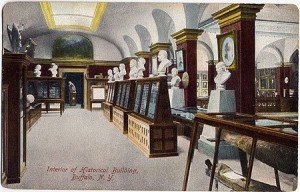 The Society for the Preservation of Long Island Antiquities (SPLIA) has issued its Endangered Historic Places List for 2013. The list includes six endangered properties that exemplify the vast diversity and character of Long Island’s historic resources. Read more
The Society for the Preservation of Long Island Antiquities (SPLIA) has issued its Endangered Historic Places List for 2013. The list includes six endangered properties that exemplify the vast diversity and character of Long Island’s historic resources. Read more
Long Island
The Leadership Role of Municipal Historians
 As the new year gets underway, it is appropriate to pause and reflect on open issues from years gone by. I am referring now to the role in 2013 of the county historian as a custodian for New York State history as we forge ahead with our Path through History Project.
As the new year gets underway, it is appropriate to pause and reflect on open issues from years gone by. I am referring now to the role in 2013 of the county historian as a custodian for New York State history as we forge ahead with our Path through History Project.
The starting point for this investigation is an article which appeared on September 12, 2012 just after the summer launch in August entitled “New York State’s Curious, Century-Old Law Requiring Every City and Town to Have a Historian” by Amanda Erickson in The Atlantic Cities. Read more
New Exhibit: Long Island at Work and Play
Long Island’s story of work and play comes to life when a farmer, dust flying, rushes to market, a boy swings a baseball bat, a peddler sells fish door to door and a family, wearing their Sunday best, poses for a portrait in their new car.
The remarkable images, many of which have never been exhibited, are just some of the gems in the Society for the Preservation of Long Island Antiquities (SPLIA) collections and feature the work of such turn of the 20th century photographers as Clarence A. Purchase, Arthur S. Greene and Harry R. Gelwicks. Read more
James Howard Kunstler On Rescuing the American Townscape
The Society for the Preservation of Long Island Antiquities (SPLIA) will present a lecture “Rescuing the American Townscape from its Own Recent History” by author James Howard Kunstler.
James Howard Kunstler is a vocal critic of American architecture and urban planning which he describes as a tragic landscape of highway strips, parking lots, housing tracts, mega-malls, junked cities and ravaged countryside. For two decades, Kunstler has examined the growth of urban and suburban America. Read more
Signage Plans Focus on Local Historians
Is resurgence in the interest in history a sign of the time? It seems so as two initiatives to promote the importance of history and heritage of New York both use signs as a means to the end.
At the 2012 conference of the Association of Public Historians of New York State on Long Island, the William G. Pomeroy Foundation used that opportunity to announce that their organization was taking their interest in historical markers statewide. Read more
Public Historians to Converge on Long Island
 Public historians from across New York State will join forces for three days – from April 23-25, 2012 as the Association of Public Historians of New York State hold their annual conference at the Hyatt Regency Long Island in Hauppauge. The association is expecting its largest conference to date as over two hundred local government historians meet to enjoy the camaraderie and networking opportunities. Read more
Public historians from across New York State will join forces for three days – from April 23-25, 2012 as the Association of Public Historians of New York State hold their annual conference at the Hyatt Regency Long Island in Hauppauge. The association is expecting its largest conference to date as over two hundred local government historians meet to enjoy the camaraderie and networking opportunities. Read more
SPLIA to Present 2012 Preservation Awards
 As an advocate, the Society for the Preservation of Long Island Antiquities (SPLIA) works to promote the appreciation and protection of regional cultural heritage. To encourage standards of excellence and raise public awareness, their 2012 Preservation Awards recognize individuals, organizations and projects that demonstrate extraordinary achievement in the field of historic preservation on Long Island.
As an advocate, the Society for the Preservation of Long Island Antiquities (SPLIA) works to promote the appreciation and protection of regional cultural heritage. To encourage standards of excellence and raise public awareness, their 2012 Preservation Awards recognize individuals, organizations and projects that demonstrate extraordinary achievement in the field of historic preservation on Long Island.
This year’s honorees include Robert A. M. Stern Architects, Seatuck Environmental Association, the Town of Southampton, and the Aquinas Honor Society of the Immaculate Conception School.
The 2012 SPLIA Preservation Awards will be held on Sunday, April 22, 2012 at 3:00 pm at SPLIA Headquarters (161 Main Street, Cold Spring Harbor, NY 11724). The event is free, but registration is required by calling SPLIA at 631-692-4664, Monday – Friday.
Rabbit Goody: A Rare American Ingrain Carpet
Ingrain or Scotch carpeting was a main stay of early 19th century carpeting for households both common and wealthy. Woven as a two layer double cloth with geometric or curvilinear designs, ingrain carpeting became popular through the last half of the 18th century and blossomed in the 19th century.
One of only four known American produced ingrain carpets is in the collection of The Society for the Preservation of Long Island Antiquities (SPLIA). It also has the most supporting information about its manufacture at Jones Mill, located in Cold Spring Harbor, NY. Advertisements from Jones Mill appear in the newspapers during the 1830′-s and document the production of figured ingrain carpeting among other fabrics.Ingrain carpeting woven by American fancy weavers in the first half of the 19th century is distinct from the imported Scotch and Kidderminster carpets. The American versions use locally produced softer grades of wool and have a slightly different structure, more akin to the structure of woven coverlets of the same period.
It has been extremely difficult to document the American carpets because with the use of soft wools, the carpets were less durable and ended up being worn out, cut up and used for smaller rugs, and simply disappeared.
We’ve been working at Thistle Hill Weavers to reproduce the Jones Mill example both in its original color, and in a blue and white version which will be installed in SPLIA’s restored Sherwood Jayne House.
Master Weaver Rabbit Goody write about historic textiles. Her weaving studio, Thistle Hill Weavers, in Cherry Valley, NY, is a small mill modeled after the trade shops of the 19th century.
Books: The Unkechaug of Eastern Long Island
 Few people may realize that Long Island is still home to American Indians, the region’s original inhabitants. One of the oldest reservations in the United States—the Poospatuck Reservation—is located in Suffolk County, the densely populated eastern extreme of the greater New York area. The Unkechaug Indians, known also by the name of their reservation, are recognized by the State of New York but not by the federal government. A new narrative account by John A. Strong, a noted authority on the Algonquin peoples of Long Island, has been published as The Unkechaug Indians of Eastern Long Island: A History (Univ. of Oklahoma Press, 2011). The book is the first comprehensive history of the Unkechaug Indians.
Few people may realize that Long Island is still home to American Indians, the region’s original inhabitants. One of the oldest reservations in the United States—the Poospatuck Reservation—is located in Suffolk County, the densely populated eastern extreme of the greater New York area. The Unkechaug Indians, known also by the name of their reservation, are recognized by the State of New York but not by the federal government. A new narrative account by John A. Strong, a noted authority on the Algonquin peoples of Long Island, has been published as The Unkechaug Indians of Eastern Long Island: A History (Univ. of Oklahoma Press, 2011). The book is the first comprehensive history of the Unkechaug Indians.
Drawing on archaeological and documentary sources, Strong traces the story of the Unkechaugs from their ancestral past, predating the arrival of Europeans, to the present day.
Although granted a large reservation in perpetuity, the Unkechaugs were, like many Indian tribes, the victims of broken promises, and their landholdings diminished from several thousand acres to fifty-five. Despite their losses, the Unkechaugs have persisted in maintaining their cultural traditions and autonomy by taking measures to boost their economy, preserve their language, strengthen their communal bonds, and defend themselves against legal challenges.
In early histories of Long Island, the Unkechaugs figured only as a colorful backdrop to celebratory stories of British settlement. Strong’s account, which includes extensive testimony from tribal members themselves, brings the Unkechaugs out of the shadows of history and establishes a permanent record of their struggle to survive as a distinct community.
Note: Books noticed on this site have been provided by the publishers. Purchases made through this Amazon link help support this site.
Squandering the Opportunity of Crisis:Long Island Sound History
 When I was growing up in New Rochelle, more years ago than I care to remember, one required trip in the new suburban world which was being created was to Rye Playland. It was a standard family and summer camp trip from a more innocent time. I wasn’t even able to enjoy all the rides since I wasn’t tall enough to reach the red line that marked the difference between childhood and adulthood. Of course, soon after crossing that threshold, the summer camp trip ended and there were other places to go. Read more
When I was growing up in New Rochelle, more years ago than I care to remember, one required trip in the new suburban world which was being created was to Rye Playland. It was a standard family and summer camp trip from a more innocent time. I wasn’t even able to enjoy all the rides since I wasn’t tall enough to reach the red line that marked the difference between childhood and adulthood. Of course, soon after crossing that threshold, the summer camp trip ended and there were other places to go. Read more
